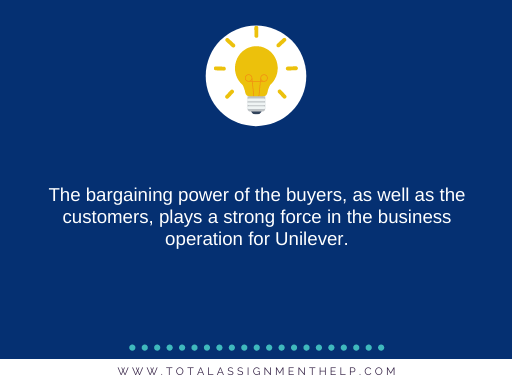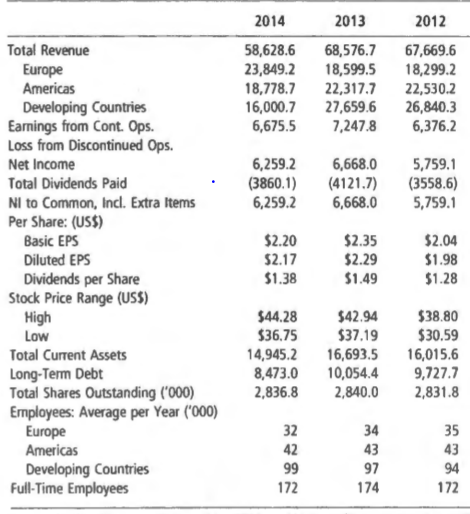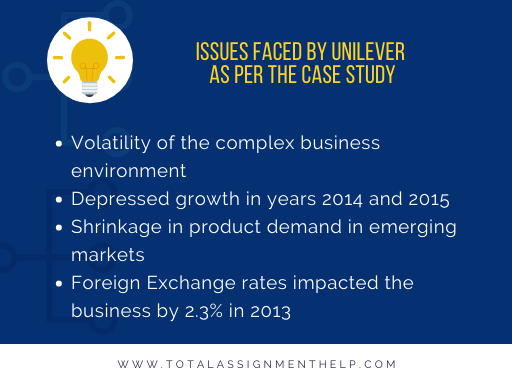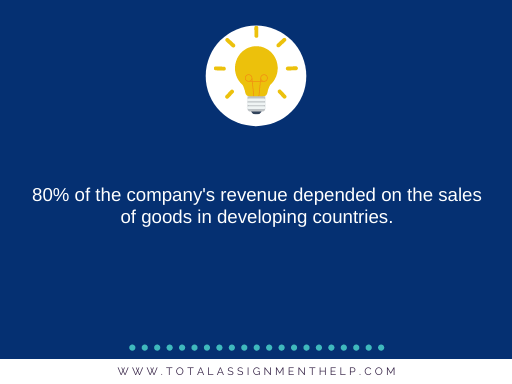Critical Analysis On The Unilever Case Study
Question
Task: Analyse the above Unilever case study using the models discussed in the class. There is considerable flexibility in how you can write the report, however the following issues should be addressed for a successful report:
- Explaining the context of Unilever’s USLP strategy based on the business environment, problem areas and Unilever’s overall strategy using the frameworks studied in the module (e.g., international, multinational, global, or transnational).
- Evaluating the effectiveness of the USLP strategy (e. exploitive, transactional, responsive or transformative) and its implementation from the standpoint of key stakeholders.
- Choose and justify one of the three strategic choices suggested at the end of the case study. Discuss potential implementation issues.
Your analysis should focus on key challenges facing the company, employing the models and tools taught in the module. As this case study is extensive and your paper is limited by wordcount, not all of the issues facing the company need to be covered; instead, you should focus on covering your chosen challenges in considerable depth. As with all cases, there are a number of acceptable approaches and there is no ‘right’ answer.
Answer
Executive Summary
An introduction has been provided on Unilever's global strategy for handling their growth and financial issues. There have been some factory issues that were clearly mentioned. The current study highlights the Unilever case that had adopted a transformational strategy responsible for the growth of sales for Unilever. The Unilever case study has been concentrated on emphasising on the various business challenges that were faced by Unilever resulted in impacting on the business operations and profitability of the company. An analysis of PESTLE and Porter’s 5 forces has been done to understand the situation of the company. A sustainable strategy has been developed for the betterment of the company. It has been looking after the characteristics of the organisation and its management. The change model has been compared to the traditional one. Lastly, a conclusion has been provided which showed that sustainability has been quite important these days.
Subscribe to our YouTube channel for more related videos
1. Introduction
This report will be doing an analysis of Unilever case study. The company has taken up the strategy of USLP so that their financial issues can be handled. It will also be helping them to manage and compete in terms of sustainability. Unilever’s strategy is transformational in nature and it is being driven by Unilever Sustainable Living Plan (USLP) (Lawrence, Rasche and Kenny 2019). The Unilever case study explains that the company has gained some impressive results through this strategy. It has helped in a difficult time. Unilever’s global strategy is explained in the Unilever case study. There were no proper set of objectives before but currently, USLP is helping them to give a competitive advantage in the market. The key issues and strategy are discussed further in details.
2. Market Introduction
2.1 Porter’s Generic Framework and how it is applied
The purpose of the Porter's Five Force is to analyse the competitive rivalry and the bargaining power of buyers that can impact the business operations in Unilever. The porter’s framework plays an effective tool in highlighting the different new entries in the market and the threats that will be created by them. The competition in the market acts as the major force that is involved in the business environment of Unilever. In the Unilever case study, there were three strong forces that can be identified that create a competitive rivalry in Unilever. These three strong forces include the aggressive nature of the marketing procedure in Unilever, the large number of firms that were operating under the Unilever and the switching cost (Bartlett 2016). According to the case, the company’s CEO Polman has implemented the culture of self-service focussing on various internal aspects so that their business size can increase. The bargaining power of the buyers, as well as the customers, plays a strong force in the business operation for Unilever. The strategies of USLP that had been adopted by the company ensured that there is a consistent growth stimulation followed by customer engagement and extra cost cut. The Unilever case study states that Unilever invested in close interaction and partnership with the suppliers that assisted them in managing bigger challenges in the operation (Bartlett 2016). The force of substitution threat allows Unilever to strengthen their revenue build-up within the company so that a good environment can persist in the industry.

2.2 What are the key issues identified in the Unilever case study?
In the business operation of Unilever, there were certain issues that have been highlighted by the Unilever case study. The major challenge that was perceived by Polman was intense volatility as well as complexities involved in the business environment (Bartlett 2016). The reports that have been reflected in the case shows that Unilever was suffering from a depressed growth in between the year 2014 to 2015. This slow growth was mostly due to the shrinkage in the product demand of Unilever in some of the emerging markets (Bartlett 2016). The impact of the newly strategized USLP was observed to be off-target. Thus, in spite of an increase in the number of shares in the market, Unilever failed to show adequate growth in sales. The declining report reflected 6.9% shrinkage in 2012, 4.3% in 2013 and 2.9% in the year 2014. Further, the foreign exchange was also observed to be impacted in the year 2013 in Unilever at a rate of 2.3%.


Figure 1: The shrinkage in the growth in between the year 2012, 2013 and 2014 in Unilever
(Source: Economicstimes.com 2020)
2.3 Factory Issues
Progress was seen for USLP in the first three years. However, by 2013 end there were mainly five points which were going off the target. Out of the five, the two major issues were Greenhouse gas emission and water usage. The GHG footprints were increasing each day even after applying the USLP strategy (Kopnina and Blewitt 2018). The increase was around 5% per consumer. Similarly, the water issues were not getting solved and the impact had grown by 15%.The shortfalls were clearly visible for environmental sensitivity. These two things were the main barriers to USLP achievement. Some calculations showed that the footprint of water was around 85% and that of GHG was around 68%. All this was happening because of some reason. People were carelessly using hot water for purposes like laundry, bathing and washing hair. The progress of Unilever was lacking because they were unable to manage the impact of customer usage. There were few innovations but the impact was limited. Unilever had to look for something bigger. Changes could be collaborated by some new partnerships. Still, some study showed that the company was providing low factory wages. This was below the international poverty level. Some issues like agricultural practices, water and deforestation need to be solved. In this way, the twin goal of Unilever can be addressed. There would be the promotion of climatic changes and human development.
3. Effectiveness of USLP strategy and its implementation
3.1 Market entry strategy
There are certain intensive strategies that can be pointed out in market penetration by Unilever. The main aim of these strategies helped in increasing the business size as well as the sales volume. With the vision of increasing the business operations and sales was planned to collaborate with the reduction in environmental footprint. This strategy adopted by Unilever had the scope of increasing their presence in society (Bartlett 2016). Further, to enhance the market penetration Polman, the then CEO of Unilever decided to tighten the operations with the implementation of certain structural changes within the organisation. The idea was that these strategies will successfully impact on Unilever’s business size and profitability. Polman observed that 80% of the company's revenue depended on the sales of goods in developing countries. So, he closely monitored the various business operations that were carried out by Unilever in the developing countries market so that their sales can be compared with the profits that were made by the competitors (Bartlett 2016). There were three goals that the company strategized so that Unilever can maintain its market position. The improvement of the health and well-being of the consumers, it can reduce the environmental footprint and enhancing the lives of the consumers.

3.2 PESTLE analysis
The various aspects that influenced the market entry for Unilever have a close link with the different external factors. In terms of the political factor, there were three situations that were cited by the Unilever case study highlighting the influence of political stability on Unilever business. Unilever catered their products both in the developed and in the developing countries. So, the free trade relations, as well as the political stabilities in these countries, played an important role in Unilever business operations (Ng'ang'a, 2015). There were several political issues like Brexit within the European Union that had the capacity of impacting on the market for Unilever since it acted as a potential threat. This threat was due to the challenges in the operational processes for the consumer market of Unilever. The sales of Unilever were a lot dependant on the stability in the developing countries. For example, the political threats in any country have an impact on the wages of the employees which can directly impact on the performance and sales of the company.
The stability in the economy of developed countries also impacted on the Unilever profitability. According to the Unilever case study, Polman identified that the business of Unilever can only be improved by concentrating on the sociocultural trends that have the ability to improve the employee's condition. This in turn also assisted the company in meeting the demands of the consumers. Unilever adopted environmentalist behaviour with the increase in health consciousness through the adoption of certain sustainability policies.
The technological aspect in the Unilever business was the adoption of business automation that had help in controlling the investments in R&D thereby impacting on the company’s profitability. With the development in the technological efficiencies, Unilever emphasised on the reduction of costs of transportation involved in manufacture units.
The ecological and environmental aspect impacted the macroenvironment of Unilever at a great extent. Unilever had taken up initiative so that the manufacturing processes result in the creation of least environmental footprint (Velásquez and Meunier 2017). This has also assisted Unilever in initiating its program for social responsibility within the company. From the legal factor, the Unilever case study emphasises three aspects that highlight the legal scenario of Unilever. As per the Unilever case study, the management board of Unilever invested on a team so that they understand the various complexities involved in the regulation related to the environmental sustainability so that the business operates in Unilever are at par with the policies(Bartlett 2016). This team closely monitored the business operation to strictly follow the legalities. Another initiative that was taken up by Unilever discussed in the Unilever case study was strengthening consumer rights and the patent laws so that the products and goods can be catered extensively in the international market.
3.3 3 conflicting sets of external demands
There were three main core goals that were emphasised by Polman considering the macro-environment of Unilever. These goals were created based on the seven commitments which were adopted by Unilever (Bartlett 2016). These seven commitments that were strategized by Unilever were further subdivided into 50 specific measurable targets that have the possibility of creating a sustainable environment. These strategies although showed promising scope for accelerating the revenue growth in the company, however the concepts of CSR policies that were adopted by Unilever were observed to create difficulties in grasping and implementing by the employees.
4. Strategic choices
4.1 Developing strategy
To measure the impact of USLP the strategy of sustainability will be helpful. Sustainability mainly comprises of a core strategy and this helps in risk reduction, growth, and cost-cutting, inspiring the employees, customer engagement and doing some innovations. Corporate Social Responsibility is having USLP under it (Grayson 2017). Unilever is having a commitment to making some tools can measure the USLP impact. Earlier in 2014, there was only the Unilever's product analysis. This was helpful in finding the growth rate and profitability. The USLP objectives were also checked. The analysis based on the Unilever case study showed that sustainable living brand would be needed for achieving the goals of this strategy. The impact on the environment will reduce and Unilever will be having sustainable living. In the year 2015, the analysis was completed. There was some evidence that growth in business is possible through sustainability. The analysis clearly showed that the solution to big issues would make a huge difference. There were some more things included in this strategy. They were hygiene and sanitation of water, deforestation and agriculture for the sustainability of the farmers. Huge environmental issues can be solved through sustainable strategy.
4.2 International structural stages
USLP strategy is not easy to build. There is a belief among the employees of Unilever that "Doing Well by Doing Good". It signifies that plantation of USLP seeds was done in fertile soil. There were some brand imprint workshops in 2006 and this was initiated by CSR groups. Such workshops provided employees with some exposure and helped in knowing the economic and environmental impacts closely. Lipton had an aim of certifying their tea and for this, they invited Rainforest Alliance. All the tea leaves were grown sustainably and responsibly sourced. There was a team in Unilever that had the job of measuring the carbon footprints (Meulensteen, Vermeulen and Meerman 2016). The major sources for it were Greenhouse Gas, waste and water. All these issues identified in the Unilever case study needed the support of USLP.
4.3 Organisational Configurations
Keith Weed was made the Leadership Executive of Unilever by Polman in the year 2010. This was being combined with the Chief Marketing Officer. Keith was having the responsibility for sustainability and communication. The functions of the market were being handled by him. If the ULE team worked properly then only USLP strategies could be developed, coordinated and implemented. CSR was not related to the sustainability of Unilever. Long term effects could be gained by implementing all the strategies of USLP slowly. CMO of the company was having the tasks which were handled by a 12-person group of corporate sustainability. All these were related to operations and marketing. USLP projects work is being done for many years. Communication was possible through intensive campaigns by the company. It was the duty of the management to hold meetings and have a forum where questions could be answered. This would be a great contribution to the early achievements.
4.4 Organisational characteristics
Media was taking interviews from Polman. United Nations also wanted to understand the USLP strategies and so meetings were being held with them.There were hardly some companies who were not having an idea about Unilever’s USLP strategy. Supply Chain Management of the company was working efficiently and Polman was happy to see this (Goel 2017).There was both dedication and passion by this management. All the new strategic challenges were being accepted and this was providing positive results and great confidence. Unilever was trying to create sync with the needs and the environment of the customers. There was some management shakeup by Polman. This led to the replacement of CMO and CFO. USLP strategy was having some radical preparations. The employees were encouraged for accepting the strategy of sustainability (Müller 2018). Some of them were having issues in accepting the rules of sustainability. However, the company initiated were motivating them to work hard.
4.5 Managing the process of change-emerging model and traditional model
As per the readings obtained from the Unilever case study, it can be stated that the process of USLP was difficult to manage. There were some continuous methods of implementation and learning that were being adopted in the Unilever case study. This helped in streamlining the transformational strategy. Most importantly, Unilever had to look after their target of solving the issues of Greenhouse Gas and water usage (Bhattacharya and Polman 2017). This was only possible when continuous reviews were done for objectives and project of USLP. There was a major emphasis given to collaboration. The company opted for partnership in other countries. Those were with the NGOs, retail chains like Wal-Mart and Tesco and small suppliers. The government was providing aid at the local and national level. Some other partners of Unilever were UNICEF, WWF Oxfam. They helped in implementing the strategy of USLP. This strategy was a traditional one but one of the change-emerging models. Earlier the thought of sustainability was not used by the companies. However, companies are opting for sustainability just like Unilever so that financial issues, growth rate and profitability can be increased. This was helpful in attracting customers from different parts of the world. GHG and water-related issues were provided attention through this strategy.
5. Conclusion
The critical analysis on the Unilever case study is performed in the above sections. The financial issues and growth of the company can be handled by a global strategy in the market. This is known as the USLP strategy. In this report firstly, the key issues of the company were highlighted. Porter’s Generic force was used for Unilever case study. The company opted for the method of the partnership while entering the new market. This was useful for solving the USLP issues. Both Porter’s 5 Forces and PESTLE analysis was done. The sustainable strategy was the developed one and suggested for the company. The details of organisational management and characteristics were provided in details.
Reference List
Bartlett, C.A., 2016. Unilever’s New Global Strategy: Competing through Sustainability. Unilever case study Harvard Business School, pp.916-414.
Bhattacharya, C.B. and Polman, P., 2017. Sustainability lessons from the front lines. MIT Sloan Management Review, 58(2), p.71.
Economictimes.com. 2019. Unilever shrinkage. Available at: https://m.economictimes.com/markets/stocks/earnings/fmcg-volumes-shrink-by-2-but-hindustan-unilever-godrej-consumer-and-dabur-report-a-6-13-jump/articleshow/39197980.cms [Accessed 4th January 2020]
Goel, A., 2017. Embedding Sustainability in Organisational Action and Thought. In Essays on Sustainability and Management (pp. 195-203). Springer, Singapore.
Grayson, D., 2017. Overview of embedding corporate sustainability. In Cranfield on Corporate Sustainability (pp. 7-26). Routledge.
Kopnina, H. and Blewitt, J., 2018. Unilever case study Sustainable business: Key issues. Routledge.
Lawrence, J., Rasche, A. and Kenny, K., 2019. Sustainability as Opportunity: Unilever’s Sustainable Living Plan. In Managing Sustainable Business (pp. 435-455). Springer, Dordrecht.
Meulensteen, T.M., Vermeulen, W.J. and Meerman, S., 2016. Creating shared value in the buyer-supplier relationship through the implementation of sustainability requirements. Global business and economics review, 18(6), pp.656-678.
Müller, F., 2018. The challenge of organizational hybridity: an investigation of Unilever’s endeavor to reconcile the Commercial and Sustainability Logic (Doctoral dissertation).
Ng’ang’a, S.I., 2015. Unilever case study The PESTLE dynamics in tea trade: Effects on return to the farmer and sustainability of the smallholder tea enterprise.
Velásquez, A. and Meunier, L., 2017. Comparative marketing analysis of the uk and germany for global sustain. Routledge.
Wang, Y. and Chaudhri, V., 2019. Business support for refugee integration in Europe: Conceptualizing the link with organizational identification. Unilever case study Media and Communication, 7(2), pp.289-299.












